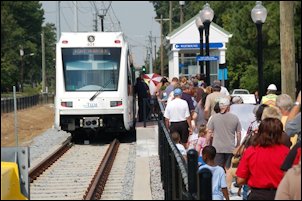by James A. Bacon
Governor Terry McAuliffe has committed to provide state support for a proposed $1.1 billion to $1.3 billion project to extend Norfolk’s light rail line, the Tide, to the Virginia Beach ocean front, according to Virginia Beach Mayor Will Sessoms. During his state of the city address, Sessoms claimed that the McAuliffe administration had made a “firm commitment” to help pay for the project. So reports the Virginian-Pilot.
McAuliffe’s staff told the newspaper that McAuliffe supports the concept of extending light rail but he needs to review a specific proposal, and has not committed any money. The governor, said a spokesman, “would need to make sure that the proposal is in line with his priorities of fostering economic development and had support from the local community.”
None of this is very reassuring. While I think it would be lovely to run light rail all the way from downtown Norfolk to Virginia Beach’s resort area, I’m not terribly impressed by the criteria enunciated by the spokesman. “Economic development” has been invoked for all manner of wasteful projects. As for “support from the local community,” any time locals see a transportation project being funded by “free” state or federal money, they tend to support it.
There is only one defensible criteria for endorsing a light rail project (or any billion-dollar transportation project, including bridges and highways): Can it pay its own way? If it can, it makes economic sense. If it can’t, it’s a boondoggle.
There are two legitimate ways to pay for light rail: through fare-box revenues and through value capture. Fare-box revenues speak for themselves. Value capture is a bit more complicated. Let’s assume the Virginia Beach leg of the Tide has 10 stops. Real estate values around each of those stops will increase, thus giving a windfall gift to property owners. Under the current practice of funding light rail, it’s all gain, no pain for property owners. Lucky them. I’ve got no problem with people making a profit — profit makes the world go round — but I do think some of that increased value should be captured to pay for the asset that creates that value.
Mayor Sessoms should draw a quarter-mile circle around every proposed rail stop (the distance most people will walk) and create a special district that will issue bonds to help pay the capital construction cost, with the bonds to be paid by a real estate tax surcharge on property owners. If property owners object, if they say the project doesn’t create enough value for them to justify the tax, Sessoms can sweeten the pot by increasing zoning densities to encourage higher-density, mixed-use development around the stations. If property owners still balk, or if bond holders don’t bite, then the project is not competitive in the capital marketplace. The money can be better invested elsewhere.
Unfortunately, there is every indication that Sesssons has decided that light rail is good for Virginia Beach…. as long as he can find someone else to help pay for it. Judging by the press accounts that I have seen, there has been no serious economic analysis of the project’s financial viability. There’s just a lot of vague, fuzzy talk about undefinable and intangible benefits.
Light rail advocates will counter that road construction projects don’t pay their own way — and they’ll be right. Virginia has abandoned the user-pays principle for funding new roads and highways. The entire system is corrupt — not in the sense that people are getting payoffs but in the sense that there is no intellectual integrity or financial discipline behind the decision-making. Sessoms can campaign as the mayor who got the light rail line built, but he won’t be around 40 years from now when the line is falling apart and needs a capital infusion of hundreds of millions of dollars, just like the Metro system in Washington, D.C., and there won’t be anyone to pay for it. Uncle Sam doesn’t fund rail maintenance. Neither does the state.
Virginians must insist that all transportation projects, or at a minimum, all mega-projects, pay for themselves. It is pure deranged craziness to expand transportation infrastructure while, thanks to the under-funding of maintenance of the transportation system we already have, that system is deteriorating. (See “America’s Road-Maintenance Deficit.”)



